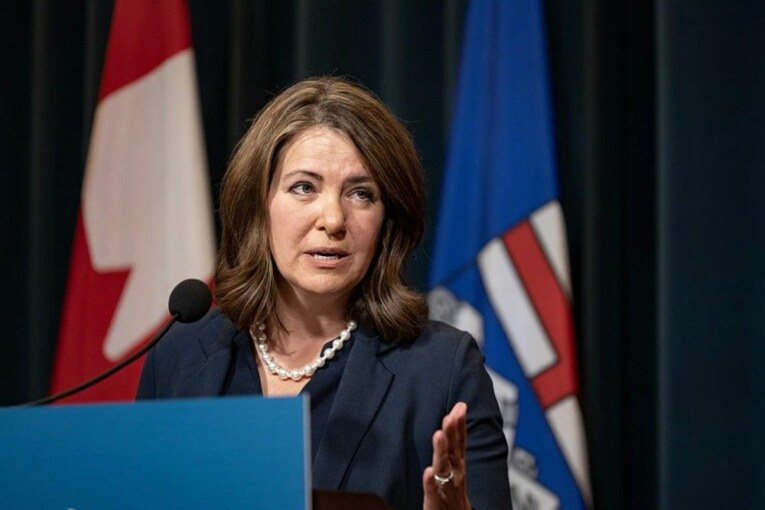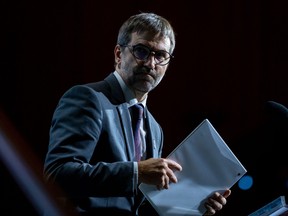
It’s a different twist on the 1970s bumper sticker about letting Eastern Canada “freeze in the dark” — Premier Danielle Smith says Ottawa will be putting Albertans at risk of being marooned in the dark because of its clean electricity plans.
Fresh off her government pausing the approval of new renewable energy projects, Smith reiterated Thursday the federal plan for a net-zero power grid by 2035 could jeopardize the reliability of the province’s power system.
Speaking to a Canadian Energy Executive Association conference in Banff, the premier blasted the Trudeau government’s push to ensure the country’s electricity system reaches net-zero emissions within a dozen years, while she also raised questions about the reliability of renewable energy during periods of extreme weather.
Alberta and Saskatchewan are pushing for a 2050 timeline to attain net zero in their power systems.
“We are offering an alternative to Ottawa’s overpriced and overhyped fantasy for a fully net-zero electricity grid by 2035,” Smith told the gathering.
“Ottawa’s plans will drive away future investments in many sectors of our economy. And Alberta will be at risk for blackouts and brownouts — and that is not an idle concern of mine.”
The Smith and Trudeau governments have been on a collision course for months over energy policy, including the federal emissions cap on the oil and gas sector emissions, and the incoming clean electricity regulations.
Earlier this month, federal Environment Minister Steven Guilbeault released draft regulations for the policy. Smith has called the federal move unconstitutional.
For Alberta and Saskatchewan, two provinces that rely on fossil fuels to generate electricity, the federal strategy is deemed to be too costly. An Alberta Electric System Operator (AESO) report last year said the price tag to reach net-zero emission by 2035 would cost up to $52 billion.

Some industry players have also expressed concern about the federal government’s timeline.
Avik Dey, CEO of Edmonton-based Capital Power, told the Canadian Press that reaching the 2035 goal is not possible in Alberta, adding: “We do believe 2045 is achievable.”
In her speech, Smith stressed the need to continue developing natural gas resources in the province to power the electricity grid and to displace coal that’s used internationally.
The premier noted that last fall, the AESO issued seven separate Level 3 critical alerts in the province, which occurs when the grid is using emergency reserves and could lead to load shedding if the balance between electricity supply and demand doesn’t improve.
“On those days, two of them when we had minus-30 weather, wind and solar were producing less than 100 megawatts of power for our power grid. Thank heavens we had natural gas to enable us to stay warm — because we could turn our furnaces on — and so that we could keep our lights on,” Smith said.
“We need to have more baseload power because when we’re at minus 30 and sometimes when we’re at plus 30, we do not have necessarily wind resources that are available to us and in the winter, we don’t even have solar resources available to us.”
Until the end of February, the Alberta Utilities Commission (AUC) will review and establish policies on granting approval to new applications for renewable energy initiatives.
Wind and solar developments have been booming in recent years, attracting billions of dollars of new investment and thousands of jobs to the province, but also raising concerns from rural municipalities and some nearby landowners.
While the pause doesn’t impact projects that already have the green light from the AUC, a number of developments are still winding their way through the early stages of the regulatory process.
The Pembina Institute said Thursday that 118 projects are currently in development and potentially affected by the moratorium. They represent at least $33 billion in investment and more than 24,000 full-time jobs for a year.
“At this point, it’s putting (investment) at risk,” said Canadian Renewable Energy Association CEO Vittoria Bellissimo.
“Decisions are being made as we speak about whether or not that risk will translate into projects and companies looking elsewhere.”
Recommended from Editorial
-

Braid: Smith takes a tough stance against Ottawa’s toothless electricity rules
-

Breakenridge: Ottawa started the fight that’s brewing over clean energy rules
-

Alberta Premier Danielle Smith says province is ready to push back against Clean Fuel Regulation
The AUC said Wednesday it will continue to process applications for renewable energy proposals during the pause, although it is prohibited from issuing approvals.
But the province is putting new renewable project investment at risk and the moratorium “sends the wrong signal to international investors,” NDP MLA Nagwan Al-Guneid told reporters.
And painting a net-zero grid by 2035 “as a way to cause blackouts is frankly irresponsible, again, because it shows that they don’t want to put the work (in) to find solutions and create the policies to attract the investments into this sector.”
The proposed Clean Electricity Regulations contain measures that would let gas-fired generation plants built before 2025 continue to run unabated — without carbon capture, utilization and storage (CCUS) technology — for 20 years.
New units that burn natural gas with CCUS would be able to keep operating beyond 2035.
“There are provisions that permit natural gas plants to continue running to support reliability and during emergencies,” Guilbeault said in a statement.
However, it’s unlikely any new gas-fired generation projects will move forward without carbon capture after 2025 if the regulations are passed, given the risk of investments being stranded.
Blake Shaffer, an electricity expert and economist at the University of Calgary, said the province will not be stuck in a situation where generators have to stop burning gas at the stroke of midnight on Jan. 1, 2035, although negotiations need to continue between the feds and provinces on the details.
But the premier raising the possibility of the federal regulations driving away investment is noteworthy, given Alberta’s pause on renewable project approvals, he added.
“The sentiment and message it casts to the renewable sector — that you’re not entirely welcome here — I’d be more worried about the damage to investment from that than I am from the clean energy regs,” Shaffer said.
“It doesn’t make any sense to me that they did this ban.”
Chris Varcoe is a Calgary Herald columnist.
You can read more of the news on source
